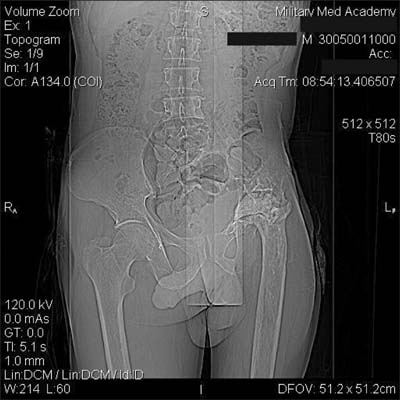Korean J Urol.
2011 Mar;52(3):221-224.
Vesico-Acetabular Fistula and Urolithiasis in the Hip Joint Cavity due to Persistent Bladder Entrapment after Acetabular Fracture
- Affiliations
-
- 1Urology Clinic, Military Medical Academy, Saint-Petersburg, Russia. yuri.tolkach@gmail.com
- 2Department of Orthopaedic Surgery, Hokkaido University, Graduate School of Medicine, Sapporo, Japan.
Abstract
- We report a rare case of vesico-acetabular fistula due to an improperly treated pelvic fracture with urinary stone formation in the joint cavity. This complication was related to an unrecognized mechanism of bladder wall entrapment in the acetabular floor defect during weight bearing. This situation led to several mistreatment decisions in our case and should be always considered by urologists dealing with patients after major pelvic trauma. In this case report, we analyze the publications related to this problem, discuss the main mechanisms of bladder wall damage after acetabular fracture, and propose tips for diagnosis and treatment.
Keyword
MeSH Terms
Figure
Reference
-
1. Porter SE, Russell GV, Dews RC, Qin Z, Woodall J Jr, Graves ML. Complications of acetabular fracture surgery in morbidly obese patients. J Orthop Trauma. 2008. 22:589–594.2. Mayo KA. Open reduction and internal fixation of fractures of the acetabulum. Results in 163 fractures. Clin Orthop Relat Res. 1994. 305:31–37.3. de Ridder VA, de Lange S, Kingma L, Hogervorst M. Results of 75 consecutive patients with an acetabular fracture. Clin Orthop Relat Res. 1994. 305:53–57.4. Ochs BG, Marintschev I, Hoyer H, Rolauffs B, Culemann U, Pohlemann T, et al. Changes in the treatment of acetabular fractures over 15 years: analysis of 1266 cases treated by the German Pelvic Multicentre Study Group (DAO/DGU). Injury. 2010. 41:839–851.5. Min W, Gaines RJ, Sagi HC. Delayed presentation of bladder entrapment secondary to nonoperative treatment of a lateral compression pelvic fracture. J Orthop Trauma. 2010. 24:e44–e48.6. Banihani MN, Al-Azab RS, Waqfi NR, Kharashgah MN, Al Manasra AR. Vesicocutaneous fistula presenting as a thigh abscess. Singapore Med J. 2009. 50:e336–e337.7. Nehme A, Maalouf G, Oakes D, Ghantous I, Trousdale RT. Persistent bladder entrapment following acetabular fracture with subsequent vesical injury during total hip arthroplasty. A case report. J Bone Joint Surg Am. 2005. 87:870–873.8. McKee MD, Waddell JP. Entrapment of the bladder in an acetabular fracture. A case report. J Bone Joint Surg Am. 1997. 79:113–117.9. Rutz E, Schäfer D, Valderrabano V. Total hip arthroplasty after hip joint ankylosis. J Orthop Sci. 2009. 14:727–731.
- Full Text Links
- Actions
-
Cited
- CITED
-
- Close
- Share
- Similar articles
-
- Treatment for the Acetabular Fracture
- Arthroscopic Management of Intraarticular Screw Perforation after Surgical Treatment of an Acetabular Posterior Wall Fracture: A Case Report
- Significance of Anatomic Reduction in Acetabular Fracture
- Arthroscopic Removal of the Intraarticular Fracture Fragment after Internal Fixation of Acetabular Fracture: A Case Report
- Radiographic findings of acetabular fractures






